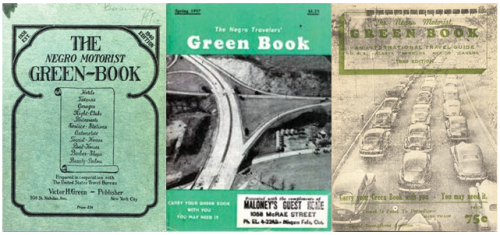
Shared posts
thesrirachacookbook: What Do Water, Beer, Milk, Gasoline, and...

What Do Water, Beer, Milk, Gasoline, and Sriracha Cost, in Dollars per Gallon?
Bon Appétit magazine looks at the comparative prices of certain liquids, per gallon. Interesting to see how it all stacks up, but no matter how much Sriracha costs, I’ll always contend that it’s WORTH EVERY PENNY.
How to find your stolen car
Tyler Cowen gets the best email. Case in point is this advice from a former cab driver on the best way to get your stolen car back:
Tags: crime how to taxis Tyler CowenIf your car is ever stolen, your first calls should be to every cab company in the city. You offer a $50 reward to the driver who finds it AND a $50 reward to the dispatcher on duty when the car is found. The latter is to encourage dispatchers on shift to continually remind drivers of your stolen car. Of course you should call the police too but first things first. There are a lot more cabs than cops so cabbies will find it first -- and they're more frequently going in places cops typically don't go, like apartment and motel complex parking lots, back alleys etc. Lastly, once the car is found, a swarm of cabs will descend and surround it because cabbies, like anyone else, love excitement and want to catch bad guys.
What you need to do to get more women at your conference — or company
Last year, Courtney Stanton organized a conference for game developers whose 12-person speaker roster was half women, and half men.
And she did it without considering the gender of applicants.
In the world of tech conferences, that gender ratio is almost unheard of — let alone getting there without actively saying yes to certain applicants just because you know they’re female.
Stanton is a product manager for a video game publisher. She wanted to put together a conference for game developers, make it accessible — and get onstage speakers more diverse than, as she put it, “the same four straight white men agree(ing) with each other on some panel.”
How did she do it? By actively recruiting women through every possible channel. She attended events and spoke to women. She encouraged women she knew to submit speaking proposals. She recruited online. She met people for coffee and promised to mentor them, review their slide decks, help them brainstorm — whatever it took to get women to apply.
That’s because, as she points out, women tend to be less assertive than men in promoting themselves. In other words, if you ask a room equally full of women and men to submit proposals to speak at a conference, the men are going to respond in far greater numbers than the women.
To balance the submissions, you need to work harder to recruit women.
Once she had proposals in hand, the balance of submissions was roughly evenly split between women and men. Stanton was able to pick what she thought were outstanding choices for each session. Result: A 50-50 split, without compromising on the quality.
Since she published her post before her event, the No Show Conference, actually took place, I contacted Stanton this week to ask her how the conference had been received.
“The actual conference went really well — the quality of the content was stellar and, across the board, very highly rated by attendees,” she told me in an email.
“I think the biggest thing the event has led to is other conferences using my approach,” Stanton added, mentioning JSConf, a programming conference in Berlin last fall, which credited her example for helping it get 25 percent female speakers.
“I’m starting to see more people talking about this idea of recruiting for submissions instead of holding spaces open for specific minority representation,” she said.
It’s an approach I’ve used when recruiting employees, whether at VentureBeat or elsewhere. If you don’t make an active effort to widen the circle of candidates, you’re just going to draw from the same pools you always draw from.
VentureBeat also produces a lot of conferences, usually with lots of dudes onstage — the photo above, from the last DEMO conference we produced, is an exception I’m especially proud of. We’re actively working on increasing the representation of women onstage, starting with our upcoming Mobile Summit. Stanton’s approach will help.
If you value diversity, you need to make an effort to recruit from groups that you aren’t part of or which aren’t usually represented in your company or your event.
But once you’ve done the outreach, consider the applicants on their merits alone. That’s the only way to ensure excellence in your outcome, whether that’s your startup team or your speaker roster.
Final note: Stanton said her conference actually opened doors for several women, who went on to speak at other conferences after making their first public-speaking appearance at hers. Talk about a ripple effect.
Hat tip: Hacker News and Attendly
Photo credit: Stephen Brashear/Flickr
Filed under: Entrepreneur, Games, VentureBeat
Gabby Giffords's Handwritten Notes for Her Testimony to the Senate Judiciary Committee
The former U.S. representative wrote her speech in pen, and on binder paper.
![[optional image description]](http://cdn.theatlantic.com/static/mt/assets/science/giffords_paper.jpg) Americans for Responsible Solutions
Americans for Responsible Solutions This morning, Gabby Giffords made an unannounced appearance at the Senate Judiciary Committee's hearing on gun violence. Assisted by her husband, former astronaut Mark Kelly, the former U.S. representative slowly and deliberately relayed her message: that "too many children are dying," that "we must do something" to fight gun violence, that "Americans are counting" on Congress to "be courageous."
Giffords's speech was striking not just for its words. It was striking as well for how painstakingly -- and in some sense how painfully -- the former congresswoman sounded each sentence, each syllable. Giffords survived her gun-inflicted brain injury against all odds, but her survival has compromised her ability to articulate her thoughts.
That is made even more clear by an image posted to the Facebook page of Americans for Responsible Solutions, the organization Giffords and Kelly founded to help reduce gun violence: the text of Giffords's speech, handwritten by Giffords herself. The pen-scrawled words, like the versions of them delivered to Congress this morning, seem deliberate. They seem diligent. They are written on a surface all too familiar to schoolchildren: binder paper.
The message Giffords and Kelly are sending though the posting of the note is clear: Guns too often kill children. But guns, too, can force adults to relearn the basic skills they once acquired naturally as children. One of the most frustrating aspects of her injury, Giffords told Diane Sawyer earlier this month, is the fact that she can understand what's going on around her -- but she is unable to articulate responses to that activity. She is trapped in her injury. And few things make that point more powerfully than a piece of binder paper and a hand-scrawled message.
Via @pbump.
 |
 |
African-American Travel and Jim Crow Segregation
We’re celebrating the end of the year with our most popular posts from 2013, plus a few of our favorites tossed in. Enjoy!
I have driven across the United States several different times. I always enjoy the experience. It reminds me of just how vast and diverse this country really is, in terms of both its nature and culture. Catching up with a friend after such a trip, I discovered that he’d never driven across the country and I insisted that he absolutely must. ”Lisa,” he said intensely, lowering his head, “not everyone is welcome in every small town in America.” My friend, you might guess, was Black.
It was a memorable lesson about my own white privilege.
This was in the 2000s, but I couldn’t help but think of it when I learned about the Green Book. A story on NPR about the book starts with the following summary:
In part, the Jim Crow era could be defined by the places African-Americans could go and the places they couldn’t. In the towns and cities where they lived, of course, blacks knew where they were welcome. On the road, though, who knew which restaurants and hotels, beauty shops and night clubs would slam doors in their faces?
The answer was ”The Negro Motorist Green Book.” First published in 1936, and revised and re-published for almost 30 years, it helped Black people travel across a hostile America.
Green wasn’t just the color. It was named after the book’s author — Victor Green — who was a postal worker. Most African Americans were familiar with where they could and couldn’t go in their own cities. So Green used his connections through the post office to collect lists from all over America, and even some other countries. These lists were invaluable to Black travelers.
Even in the depth of Jim Crow, however, Green dreamed of a better time. In the introduction he wrote (source):
There will be a day sometime in the near future when this guide will not have to be published. That is when we as a race will have equal rights and privileges in the United States.
His dream, I suppose, sort of did and sort of didn’t come true. The Green Book is out-of-print. Yet men and women like my friend still have good reason to feel uncomfortable showing their face in unfamiliar places.
Book covers borrowed from Electronic Village, AutoLife, and Phoenix Magazine. You can see a complete pdf of the book here.
Lisa Wade is a professor of sociology at Occidental College. You can follow her on Twitter and Facebook.(View original at http://thesocietypages.org/socimages)
Orthodoxy & Dissent
St. Pius X, in his encyclical Vehementer (1902), wrote: “By its very nature the church is a society of unequals; it is composed of two categories of persons: the pastors and the flocks.
The Marketing Tactics of Firearm Manufacturers
We’re celebrating the end of the year with our most popular posts from 2013, plus a few of our favorites tossed in. Enjoy!
Studying up on the literature on gun marketing for a recent interview with the New York Times, I found a 2004 article on the topic with some really interesting findings.
The study — by public health scholar Elizabeth Saylor and two colleagues — asked what tactics marketers use to sell guns in a single month of advertising. In contrast to what you might imagine, only a small minority of gun ads emphasized self-protection (3%) or a Western cowboy lifestyle (5%). Zero percent mentioned protecting one’s family. Only 15% of gun ads linked ownership to patriotism. The most common substantive theme was hunting, but even that was a theme in only 20% of ads.
So what are gun advertisers highlighting in their ads? Technical attributes. The majority of gun ads (91%) emphasize the things that make one gun different from the next. For example, they discuss the quality of the gun (61%), its accuracy (38%) and reliability (35%), and its innovative features (27%) and uniqueness (21%).
Why are gun manufacturers using this marketing strategy?
Here’s where the statistics get really interesting. At the time of the study, 44 million Americans owned firearms. Three-quarters of these owned more than one gun. In fact, 20% of gun owners are in possession of 55% of all guns (excluding law enforcement and military).
In other words, guns are not evenly distributed across the U.S. population, they are concentrated in the hands of a minority. Most people that don’t own a gun are never going to buy one, so the best strategy for gun manufacturers is to convince people that they need lots of guns. Differentiating the technical attributes of one from another is their way of telling the buyer that any given gun will do something different for them than the guns they already have, enticing the gun owner to own a range of guns instead of just one.
Cross-posted at iVoter.
Lisa Wade is a professor of sociology at Occidental College. You can follow her on Twitter and Facebook.(View original at http://thesocietypages.org/socimages)
Acoustic mirrors.
Justine Marie SherryHoth?

Acoustic mirrors.
The Berkeley Wire: 01.28.13

Photo: hammons.jane
Moss photos in rainy Berkeley, CA (Journal of a moss enthusiast)
Berkeley High rally day likely to be canceled (BHS Jacket)
New animal shelter opens in Berkeley (Daily Californian)
New BHS building is behind schedule (BHS Jacket)
Cal Chancellor to head initiative for public universities (LA Times)
Joffrey thrills in return to Berkeley (SF Chronicle)
Berkeley Teachers’ Union begins new year of negotiations (BHS Jacket)
By Berkeleyside Editors. |
Permalink |
2 comments |
Post tags:
Berkeley sex surrogate: “My work is like cooking school”
Justine Marie SherryOh, Berkeley.

Cheryl Cohen Greene: “You’re always worried about how someone is going to portray your work. I think [Helen Hunt in The Sessions] did a fabulous job”
Just in time for Oscar season, Cheryl Cohen Greene — the Berkeley-based certified sex surrogate whose relationship with the polio-stricken writer Mark O’Brien forms the basis of the indie crowd-pleaser The Sessions — has a new memoir, An Intimate Life: Sex, Love, and My Journey as a Surrogate Partner (Soft Skull Press). Here she talks with San Francisco magazine’s Nina Martin. Cohen Greene will be reading Tuesday, Jan. 29, at 7 pm at Books Inc. on Fourth St. in Berkeley.How did you decide that you wanted to do your own version of the story?
The timing with the movie was somewhat coincidental. I had been writing a book for many years [but it got derailed for various reasons, including the death of her collaborator at the time]. Eventually I found [Oakland-based coauthor] Lorna Garano, who is fabulous.
Meanwhile, [the movie’s director/screenwriter] Ben Lewin, who had polio as a child, had read Mark’s essay [On Seeing a Sex Surrogate, 1990]. It touched him so deeply and he decided to make a movie. Ben and I met [in the mid 2000s], and then for three years I didn’t see him. We talked occasionally on the phone. His wife Judi, whom I adore, said to me, “Get on his case. We have to make some money, but I want him to write this.” They actually re-mortgaged their home to finance the movie. They sold jewelry. For them, making this movie was an act of love.(...)
Read the rest of Berkeley sex surrogate: “My work is like cooking school” (370 words)
By guest. |
Permalink |
One comment |
Post tags: Books Inc, Cheryl Cohen Greene, Helen Hunt, San Francisco Magazine, The Sessions
Happy 200th Anniversary, Pride and Prejudice!





Happy 200th Anniversary, Pride and Prejudice!
Community says ‘no way’ to new signs at Marin Circle
Justine Marie SherrySeriously way to ruin the pretty?

“Right of way” signs that were put up at the Marin Circle on Jan. 16, then removed 10 days later. Photo: Larry Raines
On Jan. 16 some new traffic signs were erected at Marin Circle in north Berkeley: four yellow, reflective oblongs bearing the words ‘Traffic in circle has right of way.” It wasn’t long before local residents were up in arms about the signs, claiming they were an unnecessary eyesore on an historic, cherished local landmark.
On Saturday, the city quietly removed the signs. “Victory,” declared Sara Holmes, President of Friends of the Fountain and Walk, who was one of several local residents to fire off emails to city departments, the media and and local councilman Laurie Capitelli complaining about the signs. On Saturday Holmes had received a minimalist email from the city of Berkeley’s Kevin Lewis. It read: “To all the signs will be taken down.”(...)
Read the rest of Community says ‘no way’ to new signs at Marin Circle (632 words)
By Tracey Taylor. |
Permalink |
86 comments |
Post tags: Friends of the Fountain and Walk, Marin Circle, Marin Circle Fountain
Most Women Would Rather Divorce Than Be a Housewife
We’re celebrating the end of the year with our most popular posts from 2013, plus a few of our favorites tossed in. Enjoy!
Here’s some great news. The vast majority of young people – about 80% of women and 70% of men across all races, classes, and family backgrounds — desire an egalitarian marriage in which both partners share breadwinning, housekeeping, and child rearing. The data come from Kathleen Gerson‘s fabulous 2010 book, The Unfinished Revolution.
In practice, however, egalitarian relationships are difficult to establish. Both work and family are “greedy institutions,” ones that take up lots of time and energy. Many couples find that, once children arrive, it’s impossible for both to do both with equal gusto.
With this in mind, Gerson asked her respondents what type of family they would like if, for whatever reason, they couldn’t sustain an equal partnership. She discovered that, while men’s and women’s ideals are very similar, their fallback positions deviate dramatically.
Men’s most common fallback position is to establish a neotraditional division of labor: 70% hope to convince their wives to de-prioritize their careers and focus on homemaking and raising children. Women? Faced with a husband who wants them to be a housewife or work part-time, almost three-quarters of women say they would choose divorce and raise their kids alone. In fact, despite men’s insistence on being breadwinners, women are more likely than men to say they value success in a high-paying career.
Look at this absolutely stunning data (matching ideals on the left; clashing fallback positions on the right):
One of Gerson’s interviewees, Matthew, exemplifies the egalitarian willing to fallback on a neotraditional family form:
If I could have the ideal world, I’d like to have a partner who’s making as much as I am—someone who’s ambitious and likes to achieve. [But] if it can’t be equal, I would be the breadwinner and be there for helping with homework at night.
And this is what women think of that:
My mother’s such a leftover from the fifties and did everything for my father. I’m not planning to fall into that trap. I’m really not willing to take that from any guy at all.
Alas, what appears to be a happy convergence between men’s and women’s ideals — both are egalitarians — can turn into an intractable situation: a man who won’t give up his role as the breadwinner and a woman who would rather do anything than be a housewife.
Cross-posted at Ms., PolicyMic, and The Huffington Post.
Lisa Wade is a professor of sociology at Occidental College. You can follow her on Twitter and Facebook.(View original at http://thesocietypages.org/socimages)
Study: If You Multitask Often, You're Impulsive and Bad at Multitasking
People who do it the most are actually the worst at it.
 Jason Redmond/Reuters
Jason Redmond/Reuters PROBLEM: With the exception of texting while driving, which is absolutely deplorable, the ability to juggle multiple tasks at once is generally seen as impressive and, despite the fact that research suggests it actually makes it harder for us to process information, even necessary for getting by in modern society,

- Our Oceans Are So Acidic They're Dissolving Snails
- Midnight Snacks Mess Us Up on a Molecular Level
- Gamers Have Friends, Healthy Relationships
METHODOLOGY: Undergrads at the University of Utah were asked to rate their own multitasking prowess on a zero to 100 scale, and then were put to the test: They had to memorize a sequence of letters interspersed with simple math equations. The researchers also evaluated their impulsiveness and sensation-seeking qualities, and asked them how often they used their phones while driving and how much time they spent using various types of media.
RESULTS: There was a negative correlation between multitasking ability and practice: Those who performed worse on the test were the most frequent multitaskers in real life. The subjects in the top 25 percent of performers on the multitasking test were also the least likely to multitask.
Meanwhile, 70 percent of participants rated themselves as above-average multitaskers. Not only was this a statistical impossibility, but those same people were also more likely to multitask, including driving while using their phones. They also scored high for impulsivity and sensation-seeking behavior.
CONCLUSION: As author David Strayer succinctly put it: "The people who multitask the most tend to be impulsive, sensation-seeking, overconfident of their multitasking abilities, and they tend to be less capable of multitasking."
IMPLICATIONS: Multitasking appears to be less of a special talent and more of an ADD-type behavior: The frequent multitaskers in this study were just unable to focus on one thing at a time. As for their misplaced faith in their ability, the researchers chalk this up to people's documented inability to assess themselves accurately, especially when it's about something that's perceived as important and desirable After all, they write, "the concept of multitasking may be somewhat nebulous to laypersons." Laypersons who will just keep cooking while watching TV while forever texting, remaining woefully ignorant of their limited abilities.
The full study, "Who Multi-Tasks and Why? Multi-Tasking Ability, Perceived Multi-Tasking Ability, Impulsivity, and Sensation Seeking ," is published in the journal PLOS ONE .
 |
 |
We Need More Relatively Unattractive People to Be Naked on the Street
Justine Marie SherryLast two paragraphs. Ten minutes in the shower at the RSF locker room undo a lot of media damage to self-image, very quickly.
A new ban on public nudity will go into effect in San Francisco next week, assuming it isn't blocked by a federal judge. Said Deputy City Attorney Tara Steeley, arguing in favor of the law, "Government has a duty to protect the public that does not wish to be exposed to nudity on the streets." In dozens of trips to the Bay Area, I've wandered widely and never seen a single naked person, but if I'd stumbled across someone in the buff, I can't imagine it would've harmed me, or that there are many San Franciscans so delicate that they've suffered from these encounters:
 Reuters
Reuters There are rational public-health reasons to prohibit nudity in restaurants or on buses. Naked kids in public schools would be a distraction that harmed the learning environment. But a blanket ban that extends to all city streets, parks, and beaches? People who value freedom and pluralism ought to oppose it, especially if the given rationale is a government duty to "protect" the public from what it "does not wish" to see. I do not wish to see pigeons. I do not wish to see advertisements. I do not wish to see the subset of tattoos that depict dolphins leaping from the ocean. Tough luck for me! I'd rather not see a naked, obese octogenarian tanning in Golden Gate Park either, but if it makes her happy I can get over my shallow aesthetic preference. Like the cities that ticket youths whose sagging pants leave their underwear exposed, blanket bans on nudity are motivated mostly by a majority's desire to enforce its aesthetic preference on a minority, and to establish in law certain notions of what is moral and proper.
The aesthetic enforcers almost all offend against good taste themselves. Maybe it's their house that has an ugly paint job, or their bad haircut, or the color of the car they drive on city streets.
Few would pass muster on The Sartorialist.
It takes but a moment's reflection to see a flaw in the moralist's argument. In San Francisco next week, it will remain perfectly legal for a 50-year-old man to seduce an 18-year-old, impregnate her, ridicule her physical appearance until she is brought to tears, walk out on her, seek out her mother, seduce that mother for no other reason than to further hurt the jilted daughter, draw a graphic novel of the whole sordid chain of events, and publish in on the Internet.
But it'll be illegal for him to be naked outside.
Does anyone think the resulting moral signal is desirable?
I've never grokked the mindset of people who understand and acknowledge how unwise it would be to pass laws against many types of immoral acts, including behavior as abhorrent as what is outlined in the hypothetical above, but who insist that public nudity must be banned for moral reasons. Why do they feel compelled to ban even innocent nudity but not acts they find much more immoral?
Of course, there are people who are generally comfortable with codifying morality into law and creating victimless crimes, Dennis Prager among them. Last month, he dedicated a column to the San Francisco law. As is his habit, he began with sweeping generalizations about "Leftism" and the agenda of its adherents that bear little resemblance to the beliefs of the vast majority of actual people on the American left. That characterization flows directly into his argument:
Two of the many areas of conflict between Judeo-Christian values and leftism concern the separation between the holy and the profane and separation between humans and animals. The essence of the Hebrew Bible -- as transmitted by Christianity -- is separation: between life and death, nature and God, good and evil, man and woman and between the holy and the profane. The reasons to oppose public nudity emanate from this Judeo-Christian list of separations.The last sentence is especially absurd, but let's set it aside in favor of addressing a larger point. This idea that people are behaving in a manner indistinguishable from animals when they're naked in public is close to the opposite of my limited experience. Visit a nude beach in Spain or Italy, a sauna in Germany, or a co-ed hot springs in Oregon or Northern California, and you'll find a lot of men and women with ideological notions of how civilized naked people ought to behave.
When human beings walk around with their genitals uncovered, they are behaving in a manner indistinguishable from animals. A major difference between humans and animals is clothing; clothing separates us from -- and in the biblical view, elevates us above -- the animal kingdom. Seeing any animal's genitals is normal. Anyone who demanded that animals' genitals be covered would be regarded as a nut by the most religious Jew or Christian. But one of our human tasks is to elevate us above the animal. And covering our genitals is one important way to do that. The world of the left generally finds this animal-human distinction unnecessary.
As one clothing-optional spa in Portland puts it, the center is "a place where we try to model the change we want to see in the world. Most of our bathhouse hours are open to people of all genders. We also offer men's night and women's night weekly, plus a monthly trans and gender queer night." Typical patrons range in age from young adults to octogenarians. The rules:
Respect and uphold your own privacy and the privacy of others. All wellness sessions and services you receive ... are strictly non-sexual. We encourage patrons to focus on their own experience, enjoying the calm atmosphere and quiet company of friends who came with them. By respecting privacy we create a space where people are able to relax, with or without bathing attire, and be free from sexual issues or innuendos.That spa is about as far removed from a state of nature as is imaginable. Everyone is expected to exercise their higher brain functions and to keep their "animal impulses" tightly under control. And they do! In contrast, there are communities where people believe that if the women do not cover up their whole bodies, the men will be unable to control themselves sexually.
I find the Portland spa far more elevating and humanizing than extremist societies with enforced modesty.
Says Prager, later in his column:
The San Francisco Examiner reported about one of the protesters at the San Francisco Supervisors vote: "As he pulled his pants up, a nudist named Stardust said the legislation sent the wrong message. 'It's telling people they should be ashamed to be naked, and that's totally wrong,' he said."
But to those who believe in Judeo-Christian values, telling people to be ashamed about being naked in public is not totally wrong. It's the whole point. The first thing Adam and Eve discovered after eating from the Tree of Knowledge of Good and Evil was that they were naked. And the first emotion they ever experienced was shame over their nudity. San Francisco, America and the west are going to have to choose whether Stardust or the Bible is right.
Actually, I see nothing in the Ten Commandments that suggests public nudity ought to be prohibited, and I think Stardust's view is not at all inconsistent with the New Testament verses, "Jesus said unto him, Thou shalt love the Lord thy God with all thy heart, and with all thy soul, and with all thy mind. This is the first and great commandment. And the second is like unto it, Thou shalt love thy neighbor as thyself." As for Adam and Eve, it was God that put them on earth without clothes, distinguishing them as human, distinct from all other creatures, before they bit the apple and thought to cover themselves. Prager's biblical arguments fail even in biblical terms. (The Bible actually seems more concerned with fancy clothing and accessories than nudity.)
I know a lot of people have a visceral reaction to the idea of public nudity, and that they're inclined to trust their gut, even after they concede that none of their arguments are quite persuasive. I know people worry about their kids having to encounter naked creeps, though we'd all be immeasurably better off if creeps really did all walk around naked. (It's people who blend into trusted positions like priest, stepfather, and coach that prey on children, not eccentrics knowingly making themselves the most highly visible person on any street they're occupying.)
It saddens me that Americans sometimes put so little value on the preferences of cultural minorities, even when they aren't doing any harm. So I have one final argument to make on behalf of making space for some public nudity: It really improves way clothed people conceive of their own bodies. Talk to someone who has been to a nude beach, or read the Yelp reviews for spas where people are naked together, and you'll keep coming across comments like this one:
Odd as it may sound, it's really refreshing to spend an hour being naked amongst other naked women. I don't spend a lot of time looking at nude female bodies aside from my own, so it's a nice reminder that we're all essentially the same, yet unique. By the time I leave, I've seen so much variety that I don't even care that I have a mole on my butt.
Americans are bombarded with images of semi-clothed people all the time. It just happens that they're all beautiful actors and actresses, magazine cover girls, television underwear models, and porn stars. The average person sees lots of naked bodies, but very little real variety. While that may be more aesthetically pleasant, it skewers our notion of what a normal human body looks like. In an age of Victoria's Secret in the mall, substantial nudity on primetime television, and ubiquitous YouPorn, a ban on nonsexual street nudity begins to seem absurd. Society needs some relatively unattractive people to be naked in public now more than ever before.
 |
 |
Clerical Work

Rat Race Week continues here at OPOD with this picture of clerical workers in Baltimore Maryland in 1939. They are all typing up social security cards. I think a key aspect of Rat Race work is not so much that it is hard, but that it is meaningless. It is very hard to be a farmer, but I would bet few farmers feel like they are in the Rat Race.
Credit Card Swipe Fees Begin Sunday In USA
Read more of this story at Slashdot.
An Owl Burrito To Go, Please
These little fellows are called Saw-Whet Owls, at the University of Minnesota Raptor Center’s clinic. The clinic nurses ‘em back to health when they have medical needs.


Rachel G. spotted this on The Animal Blog.
Filed under: Uncategorized Tagged: owls
Andrew Bird at Work on TV Show for Kids

Photo by Cameron Wittig
Andrew Bird is in the beginning stages of launching his own television program for kids, as Hit Fix reports. In an interview with Hit Fix at the Sundance Film Festival, Bird said the live-action program, to be titled "Professor Socks' TV Show", is inspired by vintage "Sesame Street" other Jim Henson projects.
According to Hit Fix, Bird will play the character of a "confused professor who's out to lunch on most scientific facts." Other characters include a librarian, an "animatronic fox," and a very psychedelic-sounding "magic dresser full of magic socks." When he puts on those socks, he is transported "to other vocational worlds." Those worlds will be like "field trips" to "show kids what they could possibly be," from "how they make bubblegum to the ballet."
Music-wise, the show will serve as a "good excuse to play the old jug band stuff, the old hot jazz stuff."
Bird himself is father of a two-year-old, and a sock enthusiast, most often performing concerts without shoes on.
Watch Pitchfork.tv's mini-documentary on Bird:
January 25, 2013

Thanks again, everyone! Remember, every little bit makes the book better. There are already at least 10 exclusive comics going into it :)
When it comes to cloud data, Google tells the Feds to come back with a warrant

Google's latest transparency report reveals that the company has refused to turn over stored email to law enforcement unless a warrant is presented. The ancient Electronic Communications Privacy Act assumes that any file stored on a server for more than six months is abandoned and can be requested without a warrant, and Congress has refused to modernize this law for the age of Gmail and cloud storage (law enforcement agencies love the fact that most of your life can be fetched without having to show cause to a judge).
Google has refused to comply with warrantless requests for its users' stored cloud data, and instead demands that law enforcement officers get a warrant.
Google demands probable-cause, court-issued warrants to divulge the contents of Gmail and other cloud-stored documents to authorities in the United States — a startling revelation Wednesday that runs counter to federal law that does not always demand warrants.
The development surfaced as Google publicly announced that more than two-thirds of the user data Google forwards to government agencies across the United States is handed over without a probable-cause warrant.
A Google spokesman told Wired that the media giant demands that government agencies — from the locals to the feds — get a probable-cause warrant for content on its e-mail, Google Drive cloud storage and other platforms — despite the Electronic Communications Privacy Act allowing the government to access such customer data without a warrant if it’s stored on Google’s servers for more than 180 days.
“Google requires an ECPA search warrant for contents of Gmail and other services based on the Fourth Amendment to the Constitution, which prevents unreasonable search and seizure,” Chris Gaither, a Google spokesman, said.
I can't stress how exciting a development this is. Google has historically reserved the right to give docs to law enforcement without a warrant in its terms of service. Indeed, a group of authors asked the court to block the Google Books Settlement unless Google promised not to hand over your reading habits without a warrant. Google refused to do so. It would be wonderful to see Google enshrine "Come back with a warrant" in its terms of service, making it a promise and not just a habit.
Google Tells Cops to Get Warrants for User E-Mail, Cloud Data [Wired/David Kravets]
crocket: Mr. and Mrs. Loving, of the Supreme Court case Loving...
David Tennant To Star In Richard II For The RSC
 David Tennant will return to the stage for the Royal Shakespeare Company later this year in the title role of Richard II. The announcement was made today by the company’s new Artistic Director, Gregory Doran, at a press conference held in London this morning. The revelation ends months of speculation following internet rumours and hints by David himself that he intended to return to the stage soon. As recently as last Saturday, David advised audience members at the Project MotorMouth fan convention to ‘stay tuned’ when questioned on the subject. This marks David’s first stage work since he played Benedick in Much Ado About Nothing for Sonia Friedman Productions in 2011.
David Tennant will return to the stage for the Royal Shakespeare Company later this year in the title role of Richard II. The announcement was made today by the company’s new Artistic Director, Gregory Doran, at a press conference held in London this morning. The revelation ends months of speculation following internet rumours and hints by David himself that he intended to return to the stage soon. As recently as last Saturday, David advised audience members at the Project MotorMouth fan convention to ‘stay tuned’ when questioned on the subject. This marks David’s first stage work since he played Benedick in Much Ado About Nothing for Sonia Friedman Productions in 2011.The play will open at the Royal Shakespeare Theatre, Stratford-upon-Avon on 10th October 2013 and will run till November 16th. It will then transfer to the Barbican Theatre in London from December 9th 2013 - 25th January 2014. Gregory Doran will direct the production.
Public booking for the season opens on March 18th . Ticket prices and purchasing details will follow
The Five Fundamental Deck Types: The Combo
This is the last in a week-long series by WanderingWinder. For the introduction and links to the other posts, click here.
What characterizes the Combo?
A combo deck is a one that revolves entirely around a particular specific combo of 2+ different cards, generally getting 5-20 copies of the required cards in total. Once the combo is in place, if this has happened quickly enough, the deck should basically just win. This archetype does not deal with cards that work well together – i.e. it’s not just decks that have combos in them, a la Horse Traders-Duke, which is a Slog, or Warehouse-Treasure map, which works together well but isn’t an entire deck, but rather deals with combos that are self-contained, the-entire-deck-and-gameplan-is-this strategies. Typically, these combos are fairly resistant to adding other cards in with them.
Usually, with more than two distinct cards, you are really talking about an engine, which is a bunch of good cards that work well together and draw a lot, but this is not a hard-and-fast rule. Even things like Hunting Party stacks and Minion decks aren’t combos – they’re engines – that’s just (strong) cards being used to cycle you through, which can sometimes be extremely powerful with few cards, but isn’t a combo – there needs to also be some particular synergy, a sum-is-greater-than-the-parts, but particularly in such a way that goes beyond the normal functionality of a cards.
For instance, something like Worker’s Village and Rabble pair really nice together, as they give you actions, attack, buys, and draw – everything you need for an engine except money – but this is clearly not a combo, it is an engine, and part of how you can tell is that the parts are really modular – you might lose a little bit of efficiency by switching to another kind of Village or Smithy variant, but generally those roles can be filled by a number of other cards.
Something like Native Village/Bridge, on the other hand is very much a combo – it plays quite differently than other decks featuring these cards, and more important, you can’t get the same kind of functionality out of any other cards.
Some examples of Combo Decks include (not an exhaustive list!):
-
The Native Village/Bridge deck
- Buy nothing but Native Villages and Bridges. Use Native Village at every opportunity to put every card on the Native Village mat. When the time is right, empty your giant Native Village mat and mega-turn out with all your Bridges.
- The Chancellor(or Scavenger)/Stash deck
- Buy 4 Stashes and multiple Chancellors. Every turn, play your Chancellor, put 4 Stashes on top of your deck, and get a Province. Repeat as soon as you draw another Chancellor.
- Scavenger makes this even more powerful, since it allows you to guarantee putting a Scavenger in your hand every turn. Plus you only need 3 Stashes.
-
The Golden Deck (video)
- Bishop/Chapel into a 5 card deck of Gold/Gold/Silver/Bishop/Province (or Gold/Silver/Silver/Bishop/Province). Bishop the Province, buy a Province. Earn 5VP every turn while rushing the game end.
- The Counting House/Golem deck
- Your deck is nothing but Copper, Golems, and one Counting House. Every Golem puts your whole deck in the discard and plays the Counting House, which draws all your Copper.
-
The Apothecary/Native Village deck
- Have 8 Copper, 1 Native Village, and tons of Apothecaries. Never use Native Village blindly; only use it to filter out green cards that your Apothecaries leave on top of the deck. Once you start humming and your Apothecaries draw $8 or $11, your sole Native Village sucks up the new green card every turn, while your Apothecary leaves an Apothecary on top of the deck, essentially guaranteeing that it can keep going indefinitely.
-
Various forms of the Deck Deletion Pin deck
- The crux is that you use Masquerade to “trash” your opponent’s deck into nothing. This combo has the nice property that since your opponent starts every turn with 0 cards and ends the game with 0 cards in his deck, you can usually take your time setting it up.
- King’s Court/King’s Court/Scheme/Scheme + just about anything guarantees $8 or $11 every turn thereafter
-
Philosopher’s Stone/Herbalist
- With every buy you bloat your deck as much as possible. You buy nothing but Coppers, Philosopher’s Stones, and Herbalists. You use the Herbalist to repeatedly buy, then play, the PStone.
- Tactician/Vault
- Tactician gives you 10 cards. Vault draws you 2, to a total of 11, and you can discard up to 9 of them for $9. The remaining two cards are a Tactician and something you discard to the Tactician to repeat this process.
-
Black Market/Tactician
- Tactician gives you 10 cards. Black Market plays all your Treasures. Another Tactician discards your last card and gets you back to 10 cards next turn. Black Market saves all your Treasures from being discarded, so it’s basically like playing Dominion with 10 cards every turn.
What’s Good For Combos?
Combo pieces.
Matchups
Again, this is all dependent on what combo you’re playing, but there are some general tips. Usually, there is some weakness of the combo.
This is most commonly an attack – i.e. the Golden Deck is vulnerable to junkers and discarders. Chancellor/Stash or Scavenger/Stash is very vulnerable to discard. Scheme combos are vulnerable to Minion, and if it’s a large enough Scheme chain, Fortune Teller.
There are also other kinds of holes – for instance, combos which eventually attack the opponent into submission can be vulnerable to reactions. Most forms of the Deck Deletion pin can be blocked by Moat or Horse Traders. All deck deletion pins can get into a stalemate (or lose) if there is a massive lead for the opponent, in VP chips or on a mat somewhere, or there are drawing duration cards available. Native Village-based combos are extremely vulnerable to possession. So watch out for these things, know when they counter you, if they can be fast enough, etc. And know how to use them to counter combo decks if you are on the other side.
Combo decks are also in general vulnerable to not getting up and running in enough time. What ‘enough time’ is depends on the combo – a deck deletion pin is in time if it ever gets in before buying out the Curses (or rarely, Coppers). Others need enough expensive VP on the board, or at least 50% in many cases, to be available.
The biggest threat to making this happen is generally a strong, fast engine, as they can certainly outrace Combos, most normally if they have strong trashing to kick-start them. Rush decks also pose a serious threat in being able to finish things off too quickly for the combo to get in place.
Mirrors become strange things. Either it is a race to get the combo up first, which is a combination of 1st turn and luck, generally, with some skill on the order of the build, or very often it will end up in a 3-pile ending, where you want to build as long as you can so that you can cash out, but if you DO cash out too early, then this gives them a lot of time to build up for a bigger turn, and if you build too long, you run the risk of them three pile ending you. So the timing of when you pull the trigger, particularly if your combo is one that can go off as a matter of scale, is a huge skill in this kind of matchup. If the three pile ending is very likely, you need to watch out for defensive greening. Sometimes, a seemingly random Duchy can be VERY good – it gives you the lead, will be good in the long run, and most importantly, it can stop your opponent from being able to buy more engine components, by utilizing the threat of that three pile ending.
Filed under: Articles










